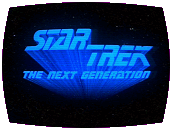 This is a syndicated series; airdates seen in this guide are the first day of the “week of” broadcast window, and episodes may have aired on different days in your area.
This is a syndicated series; airdates seen in this guide are the first day of the “week of” broadcast window, and episodes may have aired on different days in your area.
Season One: 1987-88
- Encounter At Farpoint
- The Naked Now
- Code Of Honor
- The Last Outpost
- Where No One Has Gone Before
- Lonely Among Us
- Justice
- The Battle
- Hide And Q
- Haven
- The Big Goodbye
- Datalore
- Angel One
- 11001001
- Too Short A Season
- When The Bough Breaks
- Home Soil
- Coming Of Age
- Heart Of Glory
- The Arsenal Of Freedom
- Symbiosis
- Skin Of Evil
- We’ll Always Have Paris
- Conspiracy
- The Neutral Zone
Season Two: 1988-89
- The Child
- Where Silence Has Lease
- Elementary, Dear Data
- The Outrageous Okona
- Loud As A Whisper
- The Schizoid Man
- Unnatural Selection
- A Matter Of Honor
- The Measure Of A Man
- The Dauphin
- Contagion
- The Royale
- Time Squared
- The Icarus Factor
- Pen Pals
- Q Who
- Samaritan Snare
- Up The Long Ladder
- Manhunt
- The Emissary
- Peak Performance
- Shades Of Gray
Season Three: 1989-90
- Evolution
- The Ensigns Of Command
- The Survivors
- Who Watches The Watchers?
- The Bonding
- Booby Trap
- The Enemy
- The Price
- The Vengeance Factor
- The Defector
- The Hunted
- The High Ground
- Deja Q
- A Matter Of Perspective
- Yesterday’s Enterprise
- The Offspring
- Sins Of The Father
- Allegiance
- Captain’s Holiday
- Tin Man
- Hollow Pursuits
- The Most Toys
- Sarek
- Menage àTroi
- Transfigurations
- The Best Of Both Worlds
Season Four: 1990-91
- The Best Of Both Worlds Part II
- Family
- Brothers
- Suddenly Human
- Remember Me
- Legacy
- Reunion
- Future Imperfect
- Final Mission
- The Loss
- Data’s Day
- The Wounded
- Devil’s Due
- Clues
- First Contact
- Galaxy’s Child
- Night Terrors
- Identity Crisis
- The Nth Degree
- Qpid
- The Drumhead
- Half A Life
- The Host
- The Mind’s Eye
- In Theory
- Redemption
Season Five: 1991-92
- Redemption II
- Darmok
- Ensign Ro
- Silicon Avatar
- Disaster
- The Game
- Unification I
- Unification II
- A Matter Of Time
- New Ground
- Hero Worship
- Violations
- The Masterpiece Society
- Conundrum
- Power Play
- Ethics
- The Outcast
- Cause And Effect
- The First Duty
- Cost Of Living
- The Perfect Mate
- Imaginary Friend
- I, Borg
- The Next Phase
- The Inner Light
- Time’s Arrow
Season Six: 1992-93
- Time’s Arrow Part II
- Realm Of Fear
- Man Of The People
- Relics
- Schisms
- True Q
- Rascals
- A Fistful Of Datas
- The Quality Of Life
- Chain Of Command Part I
- Chain Of Command Part II
- Ship In A Bottle
- Aquiel
- Face Of The Enemy
- Tapestry
- Birthright Part I
- Birthright Part II
- Starship Mine
- Lessons
- The Chase
- Frame Of Mind
- Suspicions
- Rightful Heir
- Second Chances
- Timescape
- Descent
Season Seven: 1993-94
- Descent Part II
- Liaisons
- Interface
- Gambit Part I
- Gambit Part II
- Phantasms
- Dark Page
- Attached
- Force Of Nature
- Inheritance
- Parallels
- The Pegasus
- Homeward
- Sub Rosa
- Lower Decks
- Thine Own Self
- Masks
- Eye Of The Beholder
- Genesis
- Journey’s End
- First Born
- Bloodlines
- Emergence
- Preemptive Strike
- All Good Things…
The Movies: 1994-2002
- Star Trek: Generations
- Star Trek: First Contact
- Star Trek: Insurrection
- Star Trek: Nemesis
With the smash success of 1986’s Star Trek IV: The Voyage Home, Paramount was suddenly very interested in the future expansion of Gene Roddenberry’s universe, even if it had 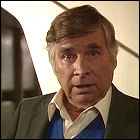 only a limited interest in Roddenberry himself having a hand in that expansion. The creator of Star Trek was viewed as something of a liability; the first and most expensive Star Trek movie, Star Trek: The Motion Picture, was regarded in hindsight as an extraordinarily expensive example of excess with Roddenberry at the helm. In actuality, however, the expense legendarily associated with The Motion Picture is actually an example of creative accounting, Hollywood style: that movie began life as an attempted TV revival in the 1970s, which followed on from two failed attempts to get an early ’70s Star Trek movie into production. By charging all of the previous unfulfilled projects against The Motion Picture‘s budget, that movie – despite a huge box office take upon its premiere – magically became a money-loser in Paramount’s books, handily accomplishing two things: it gave the spendthrift studio the ammo it needed to relieve Roddenberry of any real decision-making power in the franchise’s future, and by failing to show a profit, kept pesky residual payouts to its key players down to a dull roar. From Star Trek II onward, Gene Roddenberry was reduced to a creative consultant whose advice could be taken on
only a limited interest in Roddenberry himself having a hand in that expansion. The creator of Star Trek was viewed as something of a liability; the first and most expensive Star Trek movie, Star Trek: The Motion Picture, was regarded in hindsight as an extraordinarily expensive example of excess with Roddenberry at the helm. In actuality, however, the expense legendarily associated with The Motion Picture is actually an example of creative accounting, Hollywood style: that movie began life as an attempted TV revival in the 1970s, which followed on from two failed attempts to get an early ’70s Star Trek movie into production. By charging all of the previous unfulfilled projects against The Motion Picture‘s budget, that movie – despite a huge box office take upon its premiere – magically became a money-loser in Paramount’s books, handily accomplishing two things: it gave the spendthrift studio the ammo it needed to relieve Roddenberry of any real decision-making power in the franchise’s future, and by failing to show a profit, kept pesky residual payouts to its key players down to a dull roar. From Star Trek II onward, Gene Roddenberry was reduced to a creative consultant whose advice could be taken on 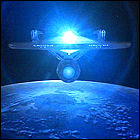 board completely or ignored at the whim of the producer behind the increasingly successful movie franchise, Harve Bennett.
board completely or ignored at the whim of the producer behind the increasingly successful movie franchise, Harve Bennett.
Late in 1986, however, Paramount decided to challenge Roddenberry’s creative instincts once more. Bennett was already touting a possible “flashback to how young Kirk and Spock first met” story, with newer, younger stars and featuring glorified cameos from William Shatner and Leonard Nimoy, for the inevitable Star Trek V. Already penciled in as that movie’s director thanks to a clause in his contract to star in Trek IV, Shatner objected and made clear that he, Nimoy and the rest of the cast would continue to star in the Star Trek films, despite approaching retirement age. Paramount contacted Roddenberry and challenged him: they wanted new Star Trek on TV, and were fully prepared to use Bennett’s “early days at Starfleet 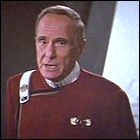 Academy” idea on the small screen… unless, of course, the creator of the original series could come up with something better.
Academy” idea on the small screen… unless, of course, the creator of the original series could come up with something better.
Roddenberry jumped at the chance. By creating a new TV series, he would be resuming a position where he had actual decision-making power with regard to the Star Trek franchise (although, technically, any future feature films and their producers were still under no obligation to heed Roddenberry’s advice as Star Trek’s permanent creative consultant). Roddenberry had hatched ideas for advancing Star Trek in the 1970s as part of the aborted Star Trek Phase II series, which would’ve been the cornerstone of the never-launched Paramount Network, and they could applied here, but in a vastly different form. The new Star Trek would not deal with Kirk and Spock at any point in their careers; it would advance the Star Trek story by “75 years” (according to an early draft of the series 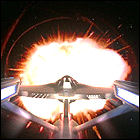 bible) and might, at most, feature a descendant of an original Enterprise crew member, though eventually even that idea fell by the wayside.
bible) and might, at most, feature a descendant of an original Enterprise crew member, though eventually even that idea fell by the wayside.
On Paramount’s end of the deal, the new Star Trek was running into a distribution problem. Though the just-launched Fox network, hungry for any programming, let alone a hit, was interested but wanted creative oversight of any series it bought from Paramount. The response from Roddenberry was predictable: he wanted nothing to do with network censorship originating from the Standards & Practices divisions like the one with whom he’d fought so many bruising battles during the original series’ tenure on NBC. As it turned out, Paramount decided to do the unexpected and explore a third option. For years, the original Trek’s 79 episodes had been bringing in a startlingly steady stream of income, despite its age; it was in syndicated reruns that the original series finally broke even and then showed a steady profit. But shown daily in many markets, those 79 episodes only amounted to a 16-week run, which was being repeated over and over again. Paramount opted to create the 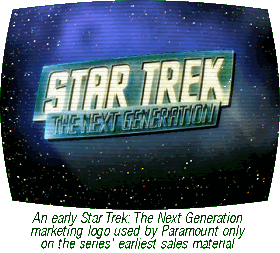 new Star Trek as a syndicated show that would never run on a specific network, instead offering the first right of refusal to the stations already carrying the ’60s show. Though there were skeptics aplenty in the broadcast industry, in fandom and in the press, most of those stations who already had Star Trek signed on for the new show.
new Star Trek as a syndicated show that would never run on a specific network, instead offering the first right of refusal to the stations already carrying the ’60s show. Though there were skeptics aplenty in the broadcast industry, in fandom and in the press, most of those stations who already had Star Trek signed on for the new show.
The new series would focus on a future Enterprise, commanded by Captain Julien Picard. (The captain’s French lineage was there from the start, inspired by oceanic explorer extraordinaire Jacques Cousteau.) Commander Bill Ryker would be the first officer and, in a development originally conceived as part of the background of the never-made ’70s revival series’ Commander Decker, Ryker would lead all landing parties, or “away missions,” with Picard 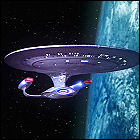 overseeing things from the safety of the Enterprise. The chief medical officer would be Doctor Beverly Crusher, who would have her bright daughter Leslie in tow, while the security of the Enterprise would be overseen by Lt. “Macha” Hernandez, a tough-as-nails security officer inspired by Roddenberry’s recent viewing of the 1986 hit movie Aliens and its gun-toting Lt. Vasquez.
overseeing things from the safety of the Enterprise. The chief medical officer would be Doctor Beverly Crusher, who would have her bright daughter Leslie in tow, while the security of the Enterprise would be overseen by Lt. “Macha” Hernandez, a tough-as-nails security officer inspired by Roddenberry’s recent viewing of the 1986 hit movie Aliens and its gun-toting Lt. Vasquez.
Behind the scenes, the faces were much more familiar. Roddenberry lured original series veterans Robert Justman and Eddie Milkis back to produce the new show, with writers D.C. Fontana and David Gerrold aboard to come up with stories and concepts. As with the original series, Roddenberry hoped to make the new show a haven for serious SF writers who wanted their material handled well, in the same way that the original Star Trek had attracted talents like Theodore 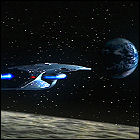 Sturgeon, George Clayton Johnson and Harlan Ellison. If anything was proving elusive, it was the shape of the future itself: how far would technology have advanced in the 24th century, when in 1986 the standard medium of data storage was a floppy disk strikingly similar in shape and size to the “computer tapes” in use aboard the Enterprise as filmed in 1966? Numerous avenues were considered and abandoned, such as having a transporter pad on the bridge itself (nixed in favor of having a relatively long elevator ride and walk to the transporter, during which conversations could take place between characters), and having the new Enterprise almost completely computer controlled, with the crew only seen to operate manual controls during the most extraordinary situations. Also to be considered was the technology of the original Star Trek: how woud it have evolved in almost a century? The idea of miniaturizing the cell-phone-like communicators of the ’60s series down into something
Sturgeon, George Clayton Johnson and Harlan Ellison. If anything was proving elusive, it was the shape of the future itself: how far would technology have advanced in the 24th century, when in 1986 the standard medium of data storage was a floppy disk strikingly similar in shape and size to the “computer tapes” in use aboard the Enterprise as filmed in 1966? Numerous avenues were considered and abandoned, such as having a transporter pad on the bridge itself (nixed in favor of having a relatively long elevator ride and walk to the transporter, during which conversations could take place between characters), and having the new Enterprise almost completely computer controlled, with the crew only seen to operate manual controls during the most extraordinary situations. Also to be considered was the technology of the original Star Trek: how woud it have evolved in almost a century? The idea of miniaturizing the cell-phone-like communicators of the ’60s series down into something 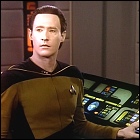 that would fit within a touch-operated uniform insignia was already on the table. What of phasers and tricorders?
that would fit within a touch-operated uniform insignia was already on the table. What of phasers and tricorders?
And for that matter, what would the show be called? “The new Star Trek” was becoming a well-worn item in entertainment news columns and the pages of Starlog Magazine (already one of the show’s biggest champions thanks to Starlog’s already-warm relationship to Paramount’s publicity department and Roddenberry in particular). There was even a brief window where the show was simply called Star Trek – it was assumed that the audience would be able to figure out quickly enough which iteration of the show it was seeing. Finally, despite the “75 years” being stretched out to a figure closer to 80 years – obviously more than a single generation – the show was titled Star Trek: The Next Generation. The characters evolved – Julien Picard became Jean-Luc Picard, Bill Ryker became Will Riker, and in the spirit of the thawing Cold War and increased cooperation with the Soviet Union, Macha Hernandez became Natasha Yar. Leslie Crusher underwent a pre-casting sex change and inherited Gene Roddenberry’s real first name, becoming Wesley Crusher. An empathic counselor, Deanna Troi, was added, and a science officer originally envisioned as a female Vulcan possibly related to Spock was nixed in favor of an android, Lt. Data, who seeks a greater understanding of human emotions and foibles – a character that Roddenberry had essentially created in his 1974 TV movie The Questor Tapes, which was intended to be a series pilot in its own right.
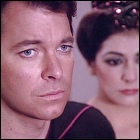 Riker and Troi inherited the slightly-cooled-down relationship originally devised for Decker and Lt. Ilia in the series bible for the aborted ’70s Star Trek revival, while Data inherited some of the character DNA developed for the never-made show’s Vulcan science officer, Xon. A blind crewmember, Geordi La Forge, would pilot the Enterprise, while another allusion to the calming of relations with the Soviet Union was added in the person of another security officer, Lt. Worf – the first Klingon to wear a Starfleet uniform, originally suggested by Bob Justman as a “Klingon marine” who would be a recurring character rather than a regular. The lineage of the Enterprise was both nailed down and left tantalizingly open by designating Picard’s ship as NCC-1701-D: what had happened to the “B” and “C” models of the Enterprise? And since NCC-1701-A had only
Riker and Troi inherited the slightly-cooled-down relationship originally devised for Decker and Lt. Ilia in the series bible for the aborted ’70s Star Trek revival, while Data inherited some of the character DNA developed for the never-made show’s Vulcan science officer, Xon. A blind crewmember, Geordi La Forge, would pilot the Enterprise, while another allusion to the calming of relations with the Soviet Union was added in the person of another security officer, Lt. Worf – the first Klingon to wear a Starfleet uniform, originally suggested by Bob Justman as a “Klingon marine” who would be a recurring character rather than a regular. The lineage of the Enterprise was both nailed down and left tantalizingly open by designating Picard’s ship as NCC-1701-D: what had happened to the “B” and “C” models of the Enterprise? And since NCC-1701-A had only 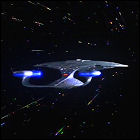 come about as a result of the original Enterprise’s destruction, what had become of Kirk’s brand new ship in the interim?
come about as a result of the original Enterprise’s destruction, what had become of Kirk’s brand new ship in the interim?
Casting and crewing up were now in full swing. A young graphic designer named Michael Okuda, operating from his home base in Hawaii, had been lobbying to work on the Star Trek movies since Star Trek III, and had gotten to do some background control panel design for the new Enterprise in Trek IV. His striking design work, coupled with his intense desire to find some logic in the ship’s display design (he had railed against Trek III‘s use of 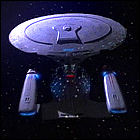 rectangular monitors peeking through circular openings in the set, especially when the graphics on those monitors made no sense in a circular format), got him a call to work on the new show full-time. Andrew Probert and Rick Sternback, both veterans of the last Enterprise redesign in Star Trek: The Motion Picture, were on hand to design the Enterprise’s newest descendant. A young executive from Paramount’s longform entertainment division, Rick Berman, was recruited by Roddenberry to help run the show. Younger than Justman (who was already expressing a desire to return to the retirement he had left to help launch TNG) and Milkis (who would be returning to retirement as soon as TNG’s
rectangular monitors peeking through circular openings in the set, especially when the graphics on those monitors made no sense in a circular format), got him a call to work on the new show full-time. Andrew Probert and Rick Sternback, both veterans of the last Enterprise redesign in Star Trek: The Motion Picture, were on hand to design the Enterprise’s newest descendant. A young executive from Paramount’s longform entertainment division, Rick Berman, was recruited by Roddenberry to help run the show. Younger than Justman (who was already expressing a desire to return to the retirement he had left to help launch TNG) and Milkis (who would be returning to retirement as soon as TNG’s 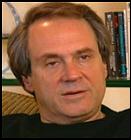 pilot was completed), Berman would be Roddenberry’s right-hand man, with a keen eye for detail and quality control, taking over Milkis’ role after the filming of the pilot. Overeeing the creative side of the show was producer Herbert J. Wright, a veteran producer of such shows as Rod Serling’s Night Gallery, The Six Million Dollar Man, Hunter and Stingray.
pilot was completed), Berman would be Roddenberry’s right-hand man, with a keen eye for detail and quality control, taking over Milkis’ role after the filming of the pilot. Overeeing the creative side of the show was producer Herbert J. Wright, a veteran producer of such shows as Rod Serling’s Night Gallery, The Six Million Dollar Man, Hunter and Stingray.
The first two seasons of the show were not easy for the series; and it was probably sheer stubborn determination in Paramount’s senior management, and a fierce desire to see the Star Trek property become a profitable success, that kept TNG from getting cancelled when most other shows, network or syndicated, would have folded under the same pressures and difficulties. Roddenberry and Wright were reportedly less than delicate in handling the writers they worked with. D.C. Fontana, the story editor of the original Star Trek and a respected editor and writer in a storied TV career since then, left the series early on; David Gerrold bailed out as well, the result of 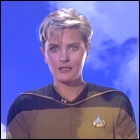 disagreements with Roddenberry over an AIDS-themed script, Blood & Fire. Gerrold and several other writers were also at odds with Roddenberry over unauthorized rewrites and script editing being carried out by Leonard Maizlish, Roddenberry’s attorney. Though there were some impressive episodes in the first two seasons, the evolving continuity of the Star Trek universe led to some inconsistencies. Denise Crosby was dissatisfied with what she saw as a lack of development for her character, Tasha Yar, and asked to be released from her contract; the character was killed off.
disagreements with Roddenberry over an AIDS-themed script, Blood & Fire. Gerrold and several other writers were also at odds with Roddenberry over unauthorized rewrites and script editing being carried out by Leonard Maizlish, Roddenberry’s attorney. Though there were some impressive episodes in the first two seasons, the evolving continuity of the Star Trek universe led to some inconsistencies. Denise Crosby was dissatisfied with what she saw as a lack of development for her character, Tasha Yar, and asked to be released from her contract; the character was killed off.
 The first season ended with two mild cliffhangers, though the lack of the words “to be continued” may have led the audience to believe otherwise. The dark, violent episode Conspiracy introduced an alien threat that had gained a foothold within Starfleet Command, trying to erode the fabric of the United Federation of Planets from inside. The story ended with an obvious hint of a rematch that, in seven years of TNG and many years of its descendants, never happened. The season closer, The Neutral Zone, introduced the idea of entire colonies and outposts vanishing without a trace, the first calling card of a powerful new enemy for the Federation. The Romulans also showed their hand, appearing in a massive new Andrew Probert-designed starship. It was Herbert Wright’s intention that the unseen enemy attacking Federation and Romulan colonies would be a relentless insect race with an all-controlling hive mind,
The first season ended with two mild cliffhangers, though the lack of the words “to be continued” may have led the audience to believe otherwise. The dark, violent episode Conspiracy introduced an alien threat that had gained a foothold within Starfleet Command, trying to erode the fabric of the United Federation of Planets from inside. The story ended with an obvious hint of a rematch that, in seven years of TNG and many years of its descendants, never happened. The season closer, The Neutral Zone, introduced the idea of entire colonies and outposts vanishing without a trace, the first calling card of a powerful new enemy for the Federation. The Romulans also showed their hand, appearing in a massive new Andrew Probert-designed starship. It was Herbert Wright’s intention that the unseen enemy attacking Federation and Romulan colonies would be a relentless insect race with an all-controlling hive mind, 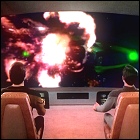 to be revealed early in the second season. Toward the end of the season, the show’s producers decided to drop Gates McFadden from the cast as Dr. Crusher, reportedly unhappy with both the actress and the development of the character. Diana Muldaur replaced McFadden for the second season as Dr. Katherine Pulaski, a curmudgeonly doctor cast from the mold of the original series’ Dr. McCoy.
to be revealed early in the second season. Toward the end of the season, the show’s producers decided to drop Gates McFadden from the cast as Dr. Crusher, reportedly unhappy with both the actress and the development of the character. Diana Muldaur replaced McFadden for the second season as Dr. Katherine Pulaski, a curmudgeonly doctor cast from the mold of the original series’ Dr. McCoy.
But that unveiling, and any momentum the series had built up, was stalled by a writers’ strike that delayed the start of filming on the secon season until the fall. The summer of 1988 saw TNG and other scripted series languish, with the new fall TV season not kicking off until November; in the absence of traditional prime-time programming, the first “reality” TV shows gained a foothold of their 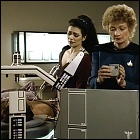 own: Fox’s Cops and America’s Most Wanted became hits during the gap in scripted shows. With the end of the writers’ strike, the opener for the second season of TNG was The Child, a hastily-revised script left over from Roddenberry’s 1970s attempt to relaunch Star Trek on TV.
own: Fox’s Cops and America’s Most Wanted became hits during the gap in scripted shows. With the end of the writers’ strike, the opener for the second season of TNG was The Child, a hastily-revised script left over from Roddenberry’s 1970s attempt to relaunch Star Trek on TV.
TNG’s second season was more confident than its first, but wasn’t without problems of its own: certain members of the cast and production team apparently didn’t get along well with Diana Muldaur, and the high turnover among writers and script editors continued as candidates for both jobs found it hard to work with Wright. A promising writer named Melinda Snodgrass, a protege of A Game Of Thrones author George R.R. Martin, brought some stability to the script editor position, but eventually left the frustration of making TNG for a literary career. Later in the second season, Wright finally got to introduce his “hive mind” enemy hinted at in The Neutral Zone, though a budget crunch turned them into the cybernetically-implanted Borg rather than a race of insects.
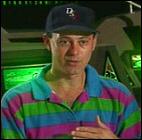 Tired of the grind after the first two seasons, Wright left TNG after headhunting his own replacement, writer Michael Piller. Having served as a journalist, a network Standards & Practices censor and a writer on such series as Simon & Simon, Piller brought a new focus on TNG’s characters to the third season, making it clear to prospective writers of the show that their scripts not only had to be about something, but about someone in show’s regular cast of characters. It was a frequent folly of ’70s and ’80s TV to bring in a guest star as a one-shot character who was more memorable than the rest of the show’s cast; Piller wanted to ensure that the same fate didn’t befall the Enterprise crew. Piller also drew from TNG’s unique-in-Hollywood open script submission policy: any unagented writer, even those who had never written a television script before, could submit a full-length script to Star Ttrek: The Next Generation after signing legal paperwork that protected Paramount from legal action in the event that a similar script went into production. This led to the discovery of writer Ronald D. Moore, who was soon
Tired of the grind after the first two seasons, Wright left TNG after headhunting his own replacement, writer Michael Piller. Having served as a journalist, a network Standards & Practices censor and a writer on such series as Simon & Simon, Piller brought a new focus on TNG’s characters to the third season, making it clear to prospective writers of the show that their scripts not only had to be about something, but about someone in show’s regular cast of characters. It was a frequent folly of ’70s and ’80s TV to bring in a guest star as a one-shot character who was more memorable than the rest of the show’s cast; Piller wanted to ensure that the same fate didn’t befall the Enterprise crew. Piller also drew from TNG’s unique-in-Hollywood open script submission policy: any unagented writer, even those who had never written a television script before, could submit a full-length script to Star Ttrek: The Next Generation after signing legal paperwork that protected Paramount from legal action in the event that a similar script went into production. This led to the discovery of writer Ronald D. Moore, who was soon 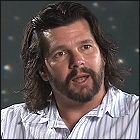 hired as a full-time staff writer for TNG and heavily publicized as the show’s Cinderella story, encouraging thousands of other would-be Star Trek scriptwriters (the author of this essay included) to send in their own stories; having gone from obscurity to a full-time career as a TV writer, Moore later gained nearly universal acclaim as the architect of the Sci-Fi Channel’s renowned 21st century revival of Battlestar Galactica. The third season even brought back Denise Crosby as a one-off Tasha Yar from an alternate timeline, and concluded with the return of Herb Wright’s Borg in a cliffhanger that achieved the impossible: it generated enough word-of-mouth and speculation that TNG was on the edge of breaking into mainstream viewing, despite being a syndicated show that aired on a different day and time in nearly every major city in the country.
hired as a full-time staff writer for TNG and heavily publicized as the show’s Cinderella story, encouraging thousands of other would-be Star Trek scriptwriters (the author of this essay included) to send in their own stories; having gone from obscurity to a full-time career as a TV writer, Moore later gained nearly universal acclaim as the architect of the Sci-Fi Channel’s renowned 21st century revival of Battlestar Galactica. The third season even brought back Denise Crosby as a one-off Tasha Yar from an alternate timeline, and concluded with the return of Herb Wright’s Borg in a cliffhanger that achieved the impossible: it generated enough word-of-mouth and speculation that TNG was on the edge of breaking into mainstream viewing, despite being a syndicated show that aired on a different day and time in nearly every major city in the country.
The fourth season was unusually stable for TNG, whose early behind-the-scenes history had been so tumultuous. Veteran TV writer Jeri Taylor joined the fold with an early fourth-season script, and a Writers’ Guild trainee named Brannon Braga became a full-time staff 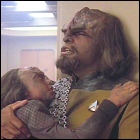 writer after a promising collaboration with Ronald D. Moore early in the season. Season five saw the brief return of Herbert Wright as a co-producer, but the contrast between his style and the stability that Michael Piller had brought to the show’s writing staff was striking. After rallying for the show’s scripts to include more “weird shit” and science fiction concepts, Wright was gone again halfway through the season, finding that the kinder, gentler writing staff at TNG was too kind and gentle for his tastes. An example Wright often cited later was that Worf was truly alien in the first two seasons, whereas the fifth season Worf was “dealing with the problems of a single father.” Season five also saw the appearance of Leonard Nimoy as the 100+ year old Spock in a heavily-promoted guest shot during the all-important November ratings sweep. The story, and Nimoy’s appearance, tied directly into the upcoming movie Star Trek VI: The Undiscovered Country, which revolved around the beginnings of peace with the Klingons as seen in the TNG timeline, and featured a cameo appearance by Michael Dorn as an ancestor of Worf. Another sign of TNG’s position of prime importance in the Star Trek franchise, Trek VI was conciously designed to be the
writer after a promising collaboration with Ronald D. Moore early in the season. Season five saw the brief return of Herbert Wright as a co-producer, but the contrast between his style and the stability that Michael Piller had brought to the show’s writing staff was striking. After rallying for the show’s scripts to include more “weird shit” and science fiction concepts, Wright was gone again halfway through the season, finding that the kinder, gentler writing staff at TNG was too kind and gentle for his tastes. An example Wright often cited later was that Worf was truly alien in the first two seasons, whereas the fifth season Worf was “dealing with the problems of a single father.” Season five also saw the appearance of Leonard Nimoy as the 100+ year old Spock in a heavily-promoted guest shot during the all-important November ratings sweep. The story, and Nimoy’s appearance, tied directly into the upcoming movie Star Trek VI: The Undiscovered Country, which revolved around the beginnings of peace with the Klingons as seen in the TNG timeline, and featured a cameo appearance by Michael Dorn as an ancestor of Worf. Another sign of TNG’s position of prime importance in the Star Trek franchise, Trek VI was conciously designed to be the 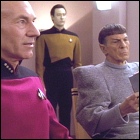 swan song for the original Star Trek cast. This unprecedented mingling of old Trek and new came as a sad footnote to the death of Star Trek creator Gene Roddenberry in October 1991.
swan song for the original Star Trek cast. This unprecedented mingling of old Trek and new came as a sad footnote to the death of Star Trek creator Gene Roddenberry in October 1991.
It was also around this time that Paramount summoned Rick Berman and Michael Piller to top-secret meetings to ask them to create another series based in the Star Trek universe. The timing of the meeting was no coincidence: with cost-of-living increases for cast and crew, TNG was only going to become more expensive to produce, and Star Trek VI was the end of the road for the original Star Trek cast members. The future of TNG was set in stone: two more seasons would be produced, after which 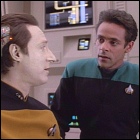 the cast and characters of Star Trek: The Next Generation would launch themselves again on the big screen; prior to that, another Star Trek spinoff would premiere on TV, carrying the franchise forward on television.
the cast and characters of Star Trek: The Next Generation would launch themselves again on the big screen; prior to that, another Star Trek spinoff would premiere on TV, carrying the franchise forward on television.
By the time TNG left the air in the spring of 1994, its new descendant, Star Trek: Deep Space Nine, was a runaway success and didn’t have to endure the same chronic teething troubles of early seasons of TNG. TNG itself was frequently praised for being one of the best-written shows on American television, and was even nominated for an Emmy for Best Dramatic Series in 1994 (thought it didn’t win); production began immediately on the first TNG movie, Star Trek: Generations, even as filming was wrapping up on the show’s two-hour series finale, and as soon as the stage lights dimmed for the last time on the sets for the 24th century Enterprise, those sets were demolished to make way for another Star Trek spinoff, Voyager. TNG had a shaky 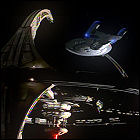 beginning, with Paramount rolling the dice on reviving a franchise that was widely seen as a TV failure and an unlikely movie success story. When NCC-1701-D made its final flight, however, Star Trek was Paramount’s biggest success story, and a cornerstone of the studio’s next major venture, the United Paramount Network.
beginning, with Paramount rolling the dice on reviving a franchise that was widely seen as a TV failure and an unlikely movie success story. When NCC-1701-D made its final flight, however, Star Trek was Paramount’s biggest success story, and a cornerstone of the studio’s next major venture, the United Paramount Network.
But that’s a story to tell later in the 24th century.

 As famous comedians Rebo and Zooty bring their unique brand of humor to Babylon 5, Captain Lochley negotiates a deal with the Brakiri ambassador to sell part of the station to them for one night as part of the Brakiri Day of the Dead celebration. Under the agreement, part of Babylon 5 will officially become part of the Brakiri homeworld for the duration of their holiday, and Lochley assumes that this is a ceremonial relocation that will take place only on paper. This assumption turns out to be wrong in every important respect when anyone remaining inside the new Brakiri borders on the station finds that they are suddenly light years away from the rest of Babylon 5.
As famous comedians Rebo and Zooty bring their unique brand of humor to Babylon 5, Captain Lochley negotiates a deal with the Brakiri ambassador to sell part of the station to them for one night as part of the Brakiri Day of the Dead celebration. Under the agreement, part of Babylon 5 will officially become part of the Brakiri homeworld for the duration of their holiday, and Lochley assumes that this is a ceremonial relocation that will take place only on paper. This assumption turns out to be wrong in every important respect when anyone remaining inside the new Brakiri borders on the station finds that they are suddenly light years away from the rest of Babylon 5.written by Neil Gaiman



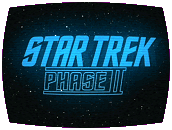


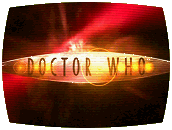

 This is a syndicated series; airdates seen in this guide are the first day of the “week of” broadcast window, and episodes may have aired on different days in your area.
This is a syndicated series; airdates seen in this guide are the first day of the “week of” broadcast window, and episodes may have aired on different days in your area. only a limited interest in Roddenberry himself having a hand in that expansion. The creator of Star Trek was viewed as something of a liability; the first and most expensive Star Trek movie, Star Trek: The Motion Picture, was regarded in hindsight as an extraordinarily expensive example of excess with Roddenberry at the helm. In actuality, however, the expense legendarily associated with The Motion Picture is actually an example of creative accounting, Hollywood style: that movie began life as an attempted TV revival in the 1970s, which followed on from two failed attempts to get an early ’70s Star Trek movie into production. By charging all of the previous unfulfilled projects against The Motion Picture‘s budget, that movie – despite a huge box office take upon its premiere – magically became a money-loser in Paramount’s books, handily accomplishing two things: it gave the spendthrift studio the ammo it needed to relieve Roddenberry of any real decision-making power in the franchise’s future, and by failing to show a profit, kept pesky residual payouts to its key players down to a dull roar. From Star Trek II onward, Gene Roddenberry was reduced to a creative consultant whose advice could be taken on
only a limited interest in Roddenberry himself having a hand in that expansion. The creator of Star Trek was viewed as something of a liability; the first and most expensive Star Trek movie, Star Trek: The Motion Picture, was regarded in hindsight as an extraordinarily expensive example of excess with Roddenberry at the helm. In actuality, however, the expense legendarily associated with The Motion Picture is actually an example of creative accounting, Hollywood style: that movie began life as an attempted TV revival in the 1970s, which followed on from two failed attempts to get an early ’70s Star Trek movie into production. By charging all of the previous unfulfilled projects against The Motion Picture‘s budget, that movie – despite a huge box office take upon its premiere – magically became a money-loser in Paramount’s books, handily accomplishing two things: it gave the spendthrift studio the ammo it needed to relieve Roddenberry of any real decision-making power in the franchise’s future, and by failing to show a profit, kept pesky residual payouts to its key players down to a dull roar. From Star Trek II onward, Gene Roddenberry was reduced to a creative consultant whose advice could be taken on  board completely or ignored at the whim of the producer behind the increasingly successful movie franchise, Harve Bennett.
board completely or ignored at the whim of the producer behind the increasingly successful movie franchise, Harve Bennett. Academy” idea on the small screen… unless, of course, the creator of the original series could come up with something better.
Academy” idea on the small screen… unless, of course, the creator of the original series could come up with something better. bible) and might, at most, feature a descendant of an original Enterprise crew member, though eventually even that idea fell by the wayside.
bible) and might, at most, feature a descendant of an original Enterprise crew member, though eventually even that idea fell by the wayside. new Star Trek as a syndicated show that would never run on a specific network, instead offering the first right of refusal to the stations already carrying the ’60s show. Though there were skeptics aplenty in the broadcast industry, in fandom and in the press, most of those stations who already had Star Trek signed on for the new show.
new Star Trek as a syndicated show that would never run on a specific network, instead offering the first right of refusal to the stations already carrying the ’60s show. Though there were skeptics aplenty in the broadcast industry, in fandom and in the press, most of those stations who already had Star Trek signed on for the new show. overseeing things from the safety of the Enterprise. The chief medical officer would be Doctor Beverly Crusher, who would have her bright daughter Leslie in tow, while the security of the Enterprise would be overseen by Lt. “Macha” Hernandez, a tough-as-nails security officer inspired by Roddenberry’s recent viewing of the 1986 hit movie Aliens and its gun-toting Lt. Vasquez.
overseeing things from the safety of the Enterprise. The chief medical officer would be Doctor Beverly Crusher, who would have her bright daughter Leslie in tow, while the security of the Enterprise would be overseen by Lt. “Macha” Hernandez, a tough-as-nails security officer inspired by Roddenberry’s recent viewing of the 1986 hit movie Aliens and its gun-toting Lt. Vasquez. Sturgeon, George Clayton Johnson and Harlan Ellison. If anything was proving elusive, it was the shape of the future itself: how far would technology have advanced in the 24th century, when in 1986 the standard medium of data storage was a floppy disk strikingly similar in shape and size to the “computer tapes” in use aboard the Enterprise as filmed in 1966? Numerous avenues were considered and abandoned, such as having a transporter pad on the bridge itself (nixed in favor of having a relatively long elevator ride and walk to the transporter, during which conversations could take place between characters), and having the new Enterprise almost completely computer controlled, with the crew only seen to operate manual controls during the most extraordinary situations. Also to be considered was the technology of the original Star Trek: how woud it have evolved in almost a century? The idea of miniaturizing the cell-phone-like communicators of the ’60s series down into something
Sturgeon, George Clayton Johnson and Harlan Ellison. If anything was proving elusive, it was the shape of the future itself: how far would technology have advanced in the 24th century, when in 1986 the standard medium of data storage was a floppy disk strikingly similar in shape and size to the “computer tapes” in use aboard the Enterprise as filmed in 1966? Numerous avenues were considered and abandoned, such as having a transporter pad on the bridge itself (nixed in favor of having a relatively long elevator ride and walk to the transporter, during which conversations could take place between characters), and having the new Enterprise almost completely computer controlled, with the crew only seen to operate manual controls during the most extraordinary situations. Also to be considered was the technology of the original Star Trek: how woud it have evolved in almost a century? The idea of miniaturizing the cell-phone-like communicators of the ’60s series down into something  that would fit within a touch-operated uniform insignia was already on the table. What of phasers and tricorders?
that would fit within a touch-operated uniform insignia was already on the table. What of phasers and tricorders? Riker and Troi inherited the slightly-cooled-down relationship originally devised for Decker and Lt. Ilia in the series bible for the aborted ’70s Star Trek revival, while Data inherited some of the character DNA developed for the never-made show’s Vulcan science officer, Xon. A blind crewmember, Geordi La Forge, would pilot the Enterprise, while another allusion to the calming of relations with the Soviet Union was added in the person of another security officer, Lt. Worf – the first Klingon to wear a Starfleet uniform, originally suggested by Bob Justman as a “Klingon marine” who would be a recurring character rather than a regular. The lineage of the Enterprise was both nailed down and left tantalizingly open by designating Picard’s ship as NCC-1701-D: what had happened to the “B” and “C” models of the Enterprise? And since NCC-1701-A had only
Riker and Troi inherited the slightly-cooled-down relationship originally devised for Decker and Lt. Ilia in the series bible for the aborted ’70s Star Trek revival, while Data inherited some of the character DNA developed for the never-made show’s Vulcan science officer, Xon. A blind crewmember, Geordi La Forge, would pilot the Enterprise, while another allusion to the calming of relations with the Soviet Union was added in the person of another security officer, Lt. Worf – the first Klingon to wear a Starfleet uniform, originally suggested by Bob Justman as a “Klingon marine” who would be a recurring character rather than a regular. The lineage of the Enterprise was both nailed down and left tantalizingly open by designating Picard’s ship as NCC-1701-D: what had happened to the “B” and “C” models of the Enterprise? And since NCC-1701-A had only  come about as a result of the original Enterprise’s destruction, what had become of Kirk’s brand new ship in the interim?
come about as a result of the original Enterprise’s destruction, what had become of Kirk’s brand new ship in the interim? rectangular monitors peeking through circular openings in the set, especially when the graphics on those monitors made no sense in a circular format), got him a call to work on the new show full-time. Andrew Probert and Rick Sternback, both veterans of the last Enterprise redesign in Star Trek: The Motion Picture, were on hand to design the Enterprise’s newest descendant. A young executive from Paramount’s longform entertainment division, Rick Berman, was recruited by Roddenberry to help run the show. Younger than Justman (who was already expressing a desire to return to the retirement he had left to help launch TNG) and Milkis (who would be returning to retirement as soon as TNG’s
rectangular monitors peeking through circular openings in the set, especially when the graphics on those monitors made no sense in a circular format), got him a call to work on the new show full-time. Andrew Probert and Rick Sternback, both veterans of the last Enterprise redesign in Star Trek: The Motion Picture, were on hand to design the Enterprise’s newest descendant. A young executive from Paramount’s longform entertainment division, Rick Berman, was recruited by Roddenberry to help run the show. Younger than Justman (who was already expressing a desire to return to the retirement he had left to help launch TNG) and Milkis (who would be returning to retirement as soon as TNG’s  pilot was completed), Berman would be Roddenberry’s right-hand man, with a keen eye for detail and quality control, taking over Milkis’ role after the filming of the pilot. Overeeing the creative side of the show was producer Herbert J. Wright, a veteran producer of such shows as Rod Serling’s Night Gallery, The Six Million Dollar Man, Hunter and Stingray.
pilot was completed), Berman would be Roddenberry’s right-hand man, with a keen eye for detail and quality control, taking over Milkis’ role after the filming of the pilot. Overeeing the creative side of the show was producer Herbert J. Wright, a veteran producer of such shows as Rod Serling’s Night Gallery, The Six Million Dollar Man, Hunter and Stingray. disagreements with Roddenberry over an AIDS-themed script, Blood & Fire. Gerrold and several other writers were also at odds with Roddenberry over unauthorized rewrites and script editing being carried out by Leonard Maizlish, Roddenberry’s attorney. Though there were some impressive episodes in the first two seasons, the evolving continuity of the Star Trek universe led to some inconsistencies. Denise Crosby was dissatisfied with what she saw as a lack of development for her character, Tasha Yar, and asked to be released from her contract; the character was killed off.
disagreements with Roddenberry over an AIDS-themed script, Blood & Fire. Gerrold and several other writers were also at odds with Roddenberry over unauthorized rewrites and script editing being carried out by Leonard Maizlish, Roddenberry’s attorney. Though there were some impressive episodes in the first two seasons, the evolving continuity of the Star Trek universe led to some inconsistencies. Denise Crosby was dissatisfied with what she saw as a lack of development for her character, Tasha Yar, and asked to be released from her contract; the character was killed off. The first season ended with two mild cliffhangers, though the lack of the words “to be continued” may have led the audience to believe otherwise. The dark, violent episode Conspiracy introduced an alien threat that had gained a foothold within Starfleet Command, trying to erode the fabric of the United Federation of Planets from inside. The story ended with an obvious hint of a rematch that, in seven years of TNG and many years of its descendants, never happened. The season closer, The Neutral Zone, introduced the idea of entire colonies and outposts vanishing without a trace, the first calling card of a powerful new enemy for the Federation. The Romulans also showed their hand, appearing in a massive new Andrew Probert-designed starship. It was Herbert Wright’s intention that the unseen enemy attacking Federation and Romulan colonies would be a relentless insect race with an all-controlling hive mind,
The first season ended with two mild cliffhangers, though the lack of the words “to be continued” may have led the audience to believe otherwise. The dark, violent episode Conspiracy introduced an alien threat that had gained a foothold within Starfleet Command, trying to erode the fabric of the United Federation of Planets from inside. The story ended with an obvious hint of a rematch that, in seven years of TNG and many years of its descendants, never happened. The season closer, The Neutral Zone, introduced the idea of entire colonies and outposts vanishing without a trace, the first calling card of a powerful new enemy for the Federation. The Romulans also showed their hand, appearing in a massive new Andrew Probert-designed starship. It was Herbert Wright’s intention that the unseen enemy attacking Federation and Romulan colonies would be a relentless insect race with an all-controlling hive mind,  to be revealed early in the second season. Toward the end of the season, the show’s producers decided to drop Gates McFadden from the cast as Dr. Crusher, reportedly unhappy with both the actress and the development of the character. Diana Muldaur replaced McFadden for the second season as Dr. Katherine Pulaski, a curmudgeonly doctor cast from the mold of the original series’ Dr. McCoy.
to be revealed early in the second season. Toward the end of the season, the show’s producers decided to drop Gates McFadden from the cast as Dr. Crusher, reportedly unhappy with both the actress and the development of the character. Diana Muldaur replaced McFadden for the second season as Dr. Katherine Pulaski, a curmudgeonly doctor cast from the mold of the original series’ Dr. McCoy. own: Fox’s Cops and America’s Most Wanted became hits during the gap in scripted shows. With the end of the writers’ strike, the opener for the second season of TNG was The Child, a hastily-revised script left over from Roddenberry’s 1970s attempt to relaunch Star Trek on TV.
own: Fox’s Cops and America’s Most Wanted became hits during the gap in scripted shows. With the end of the writers’ strike, the opener for the second season of TNG was The Child, a hastily-revised script left over from Roddenberry’s 1970s attempt to relaunch Star Trek on TV. Tired of the grind after the first two seasons, Wright left TNG after headhunting his own replacement, writer Michael Piller. Having served as a journalist, a network Standards & Practices censor and a writer on such series as Simon & Simon, Piller brought a new focus on TNG’s characters to the third season, making it clear to prospective writers of the show that their scripts not only had to be about something, but about someone in show’s regular cast of characters. It was a frequent folly of ’70s and ’80s TV to bring in a guest star as a one-shot character who was more memorable than the rest of the show’s cast; Piller wanted to ensure that the same fate didn’t befall the Enterprise crew. Piller also drew from TNG’s unique-in-Hollywood open script submission policy: any unagented writer, even those who had never written a television script before, could submit a full-length script to Star Ttrek: The Next Generation after signing legal paperwork that protected Paramount from legal action in the event that a similar script went into production. This led to the discovery of writer Ronald D. Moore, who was soon
Tired of the grind after the first two seasons, Wright left TNG after headhunting his own replacement, writer Michael Piller. Having served as a journalist, a network Standards & Practices censor and a writer on such series as Simon & Simon, Piller brought a new focus on TNG’s characters to the third season, making it clear to prospective writers of the show that their scripts not only had to be about something, but about someone in show’s regular cast of characters. It was a frequent folly of ’70s and ’80s TV to bring in a guest star as a one-shot character who was more memorable than the rest of the show’s cast; Piller wanted to ensure that the same fate didn’t befall the Enterprise crew. Piller also drew from TNG’s unique-in-Hollywood open script submission policy: any unagented writer, even those who had never written a television script before, could submit a full-length script to Star Ttrek: The Next Generation after signing legal paperwork that protected Paramount from legal action in the event that a similar script went into production. This led to the discovery of writer Ronald D. Moore, who was soon  hired as a full-time staff writer for TNG and heavily publicized as the show’s Cinderella story, encouraging thousands of other would-be Star Trek scriptwriters (the author of this essay included) to send in their own stories; having gone from obscurity to a full-time career as a TV writer, Moore later gained nearly universal acclaim as the architect of the Sci-Fi Channel’s renowned 21st century revival of Battlestar Galactica. The third season even brought back Denise Crosby as a one-off Tasha Yar from an alternate timeline, and concluded with the return of Herb Wright’s Borg in a cliffhanger that achieved the impossible: it generated enough word-of-mouth and speculation that TNG was on the edge of breaking into mainstream viewing, despite being a syndicated show that aired on a different day and time in nearly every major city in the country.
hired as a full-time staff writer for TNG and heavily publicized as the show’s Cinderella story, encouraging thousands of other would-be Star Trek scriptwriters (the author of this essay included) to send in their own stories; having gone from obscurity to a full-time career as a TV writer, Moore later gained nearly universal acclaim as the architect of the Sci-Fi Channel’s renowned 21st century revival of Battlestar Galactica. The third season even brought back Denise Crosby as a one-off Tasha Yar from an alternate timeline, and concluded with the return of Herb Wright’s Borg in a cliffhanger that achieved the impossible: it generated enough word-of-mouth and speculation that TNG was on the edge of breaking into mainstream viewing, despite being a syndicated show that aired on a different day and time in nearly every major city in the country. writer after a promising collaboration with Ronald D. Moore early in the season. Season five saw the brief return of Herbert Wright as a co-producer, but the contrast between his style and the stability that Michael Piller had brought to the show’s writing staff was striking. After rallying for the show’s scripts to include more “weird shit” and science fiction concepts, Wright was gone again halfway through the season, finding that the kinder, gentler writing staff at TNG was too kind and gentle for his tastes. An example Wright often cited later was that Worf was truly alien in the first two seasons, whereas the fifth season Worf was “dealing with the problems of a single father.” Season five also saw the appearance of Leonard Nimoy as the 100+ year old Spock in a heavily-promoted guest shot during the all-important November ratings sweep. The story, and Nimoy’s appearance, tied directly into the upcoming movie Star Trek VI: The Undiscovered Country, which revolved around the beginnings of peace with the Klingons as seen in the TNG timeline, and featured a cameo appearance by Michael Dorn as an ancestor of Worf. Another sign of TNG’s position of prime importance in the Star Trek franchise, Trek VI was conciously designed to be the
writer after a promising collaboration with Ronald D. Moore early in the season. Season five saw the brief return of Herbert Wright as a co-producer, but the contrast between his style and the stability that Michael Piller had brought to the show’s writing staff was striking. After rallying for the show’s scripts to include more “weird shit” and science fiction concepts, Wright was gone again halfway through the season, finding that the kinder, gentler writing staff at TNG was too kind and gentle for his tastes. An example Wright often cited later was that Worf was truly alien in the first two seasons, whereas the fifth season Worf was “dealing with the problems of a single father.” Season five also saw the appearance of Leonard Nimoy as the 100+ year old Spock in a heavily-promoted guest shot during the all-important November ratings sweep. The story, and Nimoy’s appearance, tied directly into the upcoming movie Star Trek VI: The Undiscovered Country, which revolved around the beginnings of peace with the Klingons as seen in the TNG timeline, and featured a cameo appearance by Michael Dorn as an ancestor of Worf. Another sign of TNG’s position of prime importance in the Star Trek franchise, Trek VI was conciously designed to be the  swan song for the original Star Trek cast. This unprecedented mingling of old Trek and new came as a sad footnote to the death of Star Trek creator Gene Roddenberry in October 1991.
swan song for the original Star Trek cast. This unprecedented mingling of old Trek and new came as a sad footnote to the death of Star Trek creator Gene Roddenberry in October 1991. the cast and characters of Star Trek: The Next Generation would launch themselves again on the big screen; prior to that, another Star Trek spinoff would premiere on TV, carrying the franchise forward on television.
the cast and characters of Star Trek: The Next Generation would launch themselves again on the big screen; prior to that, another Star Trek spinoff would premiere on TV, carrying the franchise forward on television. beginning, with Paramount rolling the dice on reviving a franchise that was widely seen as a TV failure and an unlikely movie success story. When NCC-1701-D made its final flight, however, Star Trek was Paramount’s biggest success story, and a cornerstone of the studio’s next major venture, the United Paramount Network.
beginning, with Paramount rolling the dice on reviving a franchise that was widely seen as a TV failure and an unlikely movie success story. When NCC-1701-D made its final flight, however, Star Trek was Paramount’s biggest success story, and a cornerstone of the studio’s next major venture, the United Paramount Network.



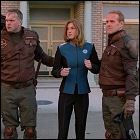 Cast: Seth MacFarlane (Captain Ed Mercer), Adrianne Palicki (Commander Kelly Grayson), Penny Johnson Jerald (Dr. Claire Finn), Scott Grimes (Lt. Gordon Malloy), Peter Macon (Lt. Commander Bortus), Halston Sage (Lt. Alara Kitan), J Lee (Lt. John LaMarr), Mark Jackson (Isaac), Chad L. Coleman (Klyden), Larry Joe Campbell (Chief Newton), Robert Knepper (Hamelac), James Morrison (Kemka), Max Burkholder (Tomilin), Norm MacDonald (voice of Yaphit), Liam Neeson (Jahavus Dorahl), Rachael MacFarlane (Computer Voice), Julie Mitchell (Woman), Kane Lieu (Security Station Officer), Casey Sander (Druyan Captain), David Hutchison (Alien Man), Michael Duisenberg (Uniformed Man #1), Derek Graf (Uniformed Man #2), Eddie Davenport (Guard #1), Justice Hedenberg (Dissident)
Cast: Seth MacFarlane (Captain Ed Mercer), Adrianne Palicki (Commander Kelly Grayson), Penny Johnson Jerald (Dr. Claire Finn), Scott Grimes (Lt. Gordon Malloy), Peter Macon (Lt. Commander Bortus), Halston Sage (Lt. Alara Kitan), J Lee (Lt. John LaMarr), Mark Jackson (Isaac), Chad L. Coleman (Klyden), Larry Joe Campbell (Chief Newton), Robert Knepper (Hamelac), James Morrison (Kemka), Max Burkholder (Tomilin), Norm MacDonald (voice of Yaphit), Liam Neeson (Jahavus Dorahl), Rachael MacFarlane (Computer Voice), Julie Mitchell (Woman), Kane Lieu (Security Station Officer), Casey Sander (Druyan Captain), David Hutchison (Alien Man), Michael Duisenberg (Uniformed Man #1), Derek Graf (Uniformed Man #2), Eddie Davenport (Guard #1), Justice Hedenberg (Dissident)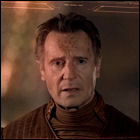 Notes: This episode of The Orville, like most others, has just a few connections to classic sci-fi. Uncredited on screen but unmistakable once he begins speaking, Liam Neeson plays the generational ship’s captain. Though he’s now associated with present-day action thrillers, Neeson has played characters who, to cite just one example,
Notes: This episode of The Orville, like most others, has just a few connections to classic sci-fi. Uncredited on screen but unmistakable once he begins speaking, Liam Neeson plays the generational ship’s captain. Though he’s now associated with present-day action thrillers, Neeson has played characters who, to cite just one example,